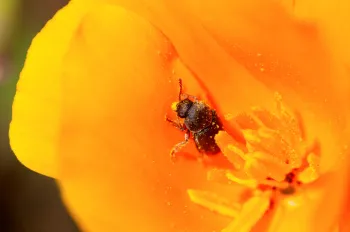
Gardening is a uniquely healthy, relaxing, and inspirational activity. Planting that seed or seedling is perhaps the ultimate expression of optimism. The beautiful blooms and bountiful harvests we labor to cultivate can provide matchless feelings of accomplishment and pride. But we don’t do it alone. The creatures we collectively call pollinators are there, in the background, working to make it possible. Many gardeners are finding great personal satisfaction observing and helping to protect the beautiful, exquisitely complex and extremely delicate world of the pollinators their gardens welcome and nurture.
What is a pollinator? The simplest definition is any agent that transfers pollen from the male portion of a flower to the female portion of a flower is a pollinator. Most pollinators work under our radar and are easily overlooked when a garden receives the admiring human gaze. A closer look into the flower of a plant in bloom may reveal a small invertebrate creature covered in pollen. Bees, beetles, flies, wasps, moths, and butterflies are all common pollinators, but bats, birds, small mammals, and even lizards contribute pollination services to flowering plants. The goal of every creature we call a pollinator is the caloric reward of nectar or pollen that will power them to the next flower. Along the way, they will inadvertently be carrying pollen. When they visit that next genetically compatible and receptive flower, pollination can happen. Because many pollinators co-evolved with flowering plants, they can be mutually dependent. A hummingbird hovering in front of a salvia is a more specialized pollinator, uniquely equipped to draw nectar from long tubular flowers while picking up and carrying pollen to the next. Many pollinators will visit a wide selection of flowers, but some like the iconic Monarch Butterfly depend exclusively on one plant, the milkweed, to complete its life cycle. Even the wind can be a pollinator. But the wind is not threatened with extinction. It is estimated that the Western Monarch has suffered a 99% reduction in its population since the 1980s, largely because of habitat loss. That means that it can’t find the once ubiquitous milkweed plants it needs to complete its complex lifecycle and remarkable migration. Because its decline has been closely studied, the monarch is considered a “signal” species. It is raising a faded orange and black flag, signaling that it is likely many of the other 350,000 pollinator species worldwide are also in decline. All pollinators contribute in their own unique way to the biodiversity upon which our entire ecosystem and our agricultural systems depend.

The good news is that we can all help extend the habitat and migratory corridors by planting pollinator-friendly plants in our home gardens. Ideally, they are planted in groupings, with an eye toward sequential bloom over the course of Marin’s growing season. More is always better, but even just a few in pots or planters on porches and balconies can provide a vital nutritional oasis.
This is where the UC Marin Master Gardeners are actively assisting the home gardener. Their annual Pollinator Plant Sale is next week, and they have carefully selected over 40 different species of plants for this sale. These plants are beautiful, highly desirable to a range of pollinators, and well suited to growing in Marin’s Mediterranean climate. The sale will include over 250 Narrowleaf Milkweeds, multiple varieties of Cosmos, Coneflowers, Lupines, Salvias, and many other species.
The UC Marin Master Gardener website below contains informative links to the sale, including photos, descriptions, and the important cultural needs of each species. https://marinmg.ucanr.edu/ASK_US/EVENTS/PollinatorPlants/
The UC Marin Master Gardener Pollinator Plant Sale will be held on March 1, 2025, at the Falkirk Greenhouse, 1408 Mission Avenue, San Rafael. 9 am until noon. Master Gardeners will be on-site to help answer any questions.
By Terry Amerson

